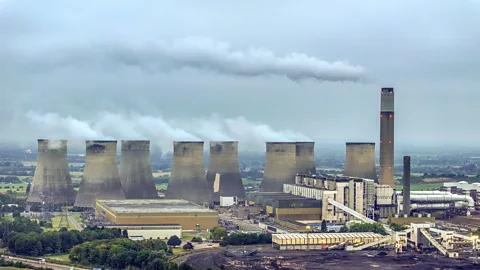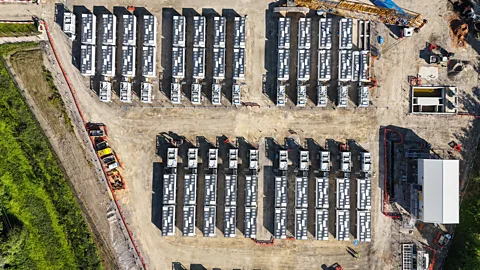 Getty Images
Getty ImagesWith the closure of the last coal-fired power station in the UK, it raises questions about how old fossil fuel infrastructure can be repurposed. One option is to use them to store energy from renewables.
It’s an unassuming place for a major era of British history to come to an end. Surrounded by farmland drenched by recent rains and trees with leaves starting to turn ahead of the autumn – all within earshot of the thundering traffic from the M1 motorway – the UK’s last coal-fired power station is shutting down for good. As of 30 September 2024 the turbines at the Ratcliffe-on-Soar power plant in Nottinghamshire will fall silent while smoke and steam will cease to belch from the chimney and cooling towers that dominate this part of the landscape.
It’s a symbolic moment, a marker along the UK’s journey to decarbonisation and net-zero. For centuries, coal was the main source of energy in the UK. It was the life-blood of the industrial revolution – providing the fuel for steam engines and then generating much of the country’s electricity. By the 1960s, nearly 90% of the UK’s electricity relied upon coal.
Now, for the first time, the UK will not use any coal to generate electricity.
It’s not clear what the Ratcliffe-on-Soar site will become. There have been suggestions it could house a prototype fusion reactor or some other green industry. Regardless, as fossil fuel power plants are shuttered in many parts of the world, the question of what to do with them will keep coming up.
One promising option is to turn old fossil power plants into battery storage sites.
The intermittency problem
Renewable energy sources like wind and solar are the mainstay of the net-zero transition. They don’t emit greenhouse gases, so the more they replace fossil fuels like coal and gas the closer we come to net-zero emissions.
However, using renewables comes with challenges for power grids. Coal and gas plants can be turned on and off at will, so they can supply more energy when it is needed: they are “dispatchable”, in the jargon of the field. By contrast, renewable sources are intermittent and less controllable: the Sun doesn’t shine at night and the wind doesn’t always blow (and sometimes can blow too much).
“With renewables, we have less dispatchable power,” says Grazia Todeschini, an electrical engineer at King’s College London in the UK.
To some extent, the intermittency problem can be managed by having a diverse selection of renewable sources: that way, if one doesn’t generate enough, another can pick up the slack. Nuclear power, which is zero-carbon, also offers a steady supply.
Alongside this, though, countries are investing heavily in energy storage. When lots of electricity is generated but isn’t needed, it can be stored – then when there is a shortage it can be released. “The main point is to be able to match generation and demand,” says Todeschini.
 Getty Images
Getty ImagesFor many decades, the most important form of energy storage was pumped hydropower. Excess electricity was used to pump water uphill, so that it could be released to drive turbines and generate electricity when needed. However, this won’t be enough for the renewable era, and hydropower has its own emission problems too. “That capacity pretty much is saturated everywhere, in Europe at least,” says Todeschini. “There is no space to build any more.”
“In the last 20 years, this technology has improved a lot,” says Todeschini. “The control is more precise, and also the cost has decreased.”
All of which explains why one of the UK’s defunct coal plants is being turned into a BESS site.
Ferrybridge
Near Ferrybridge in West Yorkshire sit the remains of a trio of coal-fired power plants. Between them they operated for almost a century, the first one turning on in 1927 and the last being decommissioned in 2016. The third station, Ferrybridge C, passed into the ownership of energy company SSE in 2004, which ran it until the site’s closure and demolition.
“We’re now at the point all the kit’s on site,” says Heather Donald of SSE Renewables, where she is director of onshore wind, solar and battery for Great Britain and Ireland. “We’re just about to go into the commissioning phase and we’re hoping to switch on early next year.”
Building an array of batteries on the site of an old coal-fired power station has multiple advantages, says Donald. “First and foremost, there’s a grid connection there,” she says. That means linking the BESS to the grid is as straightforward as it can be. “Access to grid connections and grid capacity’s at such a premium now.”
The site also proved to have a lot of useful materials and infrastructure. “We’ve been able to use some of the existing concrete foundations, we’ve been able to repurpose some of the concrete on site,” says Donald. This meant the company did not need to import many materials, apart from the batteries themselves.
“It’s a great reuse of a site like this,” says Donald.
More of this sort of thing
If the UK is to achieve its decarbonisation targets, it will need a lot more BESS projects like Ferrybridge.
Some indication of quite how many more can be gleaned from the latest Future Energy Scenarios report, released in July 2024 by National Grid. The report finds the UK had 4.7 gigawatts (GWs) of battery storage capacity in 2023. That’s a lot, but the UK government has set a legally binding target of net-zero emissions by 2050. Depending on quite how this is achieved, the country will need storage of between 29 gigawatts and 36 gigawatts by 2050. Even the lower figure is only possible if the UK stores a lot of its energy in the form of hydrogen. Currently, most hydrogen comes from fossil fuel sources, so a switch to greener alternatives is needed. If green hydrogen does not take off, the country will need more BESS to compensate.
In short, the UK’s BESS capacity needs to increase by a factor of at least six, and possibly closer to eight, in the next quarter-century.
 Getty Images
Getty ImagesGiven the massive increase in battery capacity needed, disused power stations like Ferrybridge C are a tempting option. “To be able to use former energy sites for new carbon-free energy is definitely something we’re looking to do more of,” says Donald.
Indeed, SSE is already building a second BESS on another coal-fired power station site. Fiddler’s Ferry in Warrington, Cheshire, was shut down in 2020, and in December 2023 the company announced it would turn it into a 150-megawatt BESS. Construction began in the spring of 2024.
“I agree it makes sense to use a site where there is already some of this infrastructure,” says Todeschini.
That said, not all ex-fossil-fuel power stations will be suitable for BESS. “It really depends a lot on the location,” says Todeschini. For instance, a site that’s a long way from residential neighbourhoods might not be suitable. Instead, such sites could be repurposed as wind farms or other forms of generation. Todeschini also suggests charging sites for fleets of electric vehicles.
“I’m an advocate for this kind of mixed approach, in general, for the energy transition,” says Todeschini. “My approach is to really consider all options.”
On the other side of the world, the former Liddell Power Station in New South Wales, Australia, is becoming the Liddell Battery. The site’s owner AGL Energy announced the project in December 2023 and construction began in June 2024. The 500-megawatt batteries should come online in December 2025.
The more projects like these come online, the better they will become, argues Donald. “It’s obviously an emerging technology,” she says. Donald expects BESS to become more efficient and to be able to discharge electricity for longer periods – helping ensure a secure electricity supply after all the fossil fuel plants have been turned off for good.

